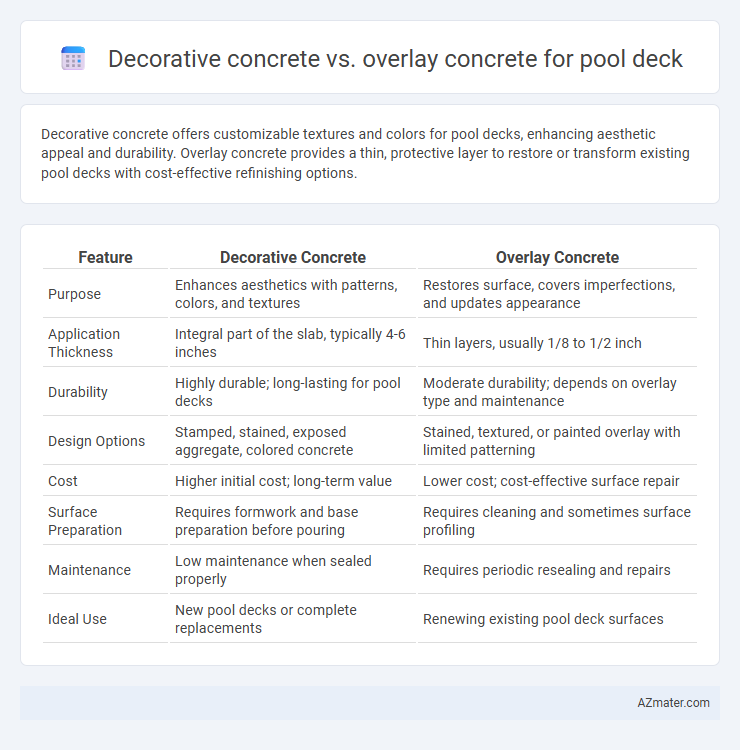Decorative concrete offers customizable textures and colors for pool decks, enhancing aesthetic appeal and durability. Overlay concrete provides a thin, protective layer to restore or transform existing pool decks with cost-effective refinishing options.
Table of Comparison
| Feature | Decorative Concrete | Overlay Concrete |
|---|---|---|
| Purpose | Enhances aesthetics with patterns, colors, and textures | Restores surface, covers imperfections, and updates appearance |
| Application Thickness | Integral part of the slab, typically 4-6 inches | Thin layers, usually 1/8 to 1/2 inch |
| Durability | Highly durable; long-lasting for pool decks | Moderate durability; depends on overlay type and maintenance |
| Design Options | Stamped, stained, exposed aggregate, colored concrete | Stained, textured, or painted overlay with limited patterning |
| Cost | Higher initial cost; long-term value | Lower cost; cost-effective surface repair |
| Surface Preparation | Requires formwork and base preparation before pouring | Requires cleaning and sometimes surface profiling |
| Maintenance | Low maintenance when sealed properly | Requires periodic resealing and repairs |
| Ideal Use | New pool decks or complete replacements | Renewing existing pool deck surfaces |
Introduction to Pool Deck Surfacing Options
Decorative concrete enhances pool decks with customized patterns, colors, and textures, offering a stylish and durable surface that complements outdoor aesthetics. Overlay concrete serves as a thin, protective layer applied over existing surfaces to repair and renew pool decks while adding slip resistance and weather durability. Both options improve safety and visual appeal, with decorative concrete focusing on design versatility and overlay concrete emphasizing surface restoration.
What is Decorative Concrete?
Decorative concrete for pool decks involves using techniques such as stamping, staining, and engraving to create visually appealing, textured surfaces that mimic natural materials like stone or tile. This method enhances durability and slip resistance while offering customizable colors and patterns to complement outdoor aesthetics. Unlike overlay concrete, decorative concrete integrates design directly into the concrete slab, providing long-lasting beauty tailored to specific landscaping themes.
Understanding Overlay Concrete for Pool Decks
Overlay concrete for pool decks provides a durable, thin layer applied over existing concrete surfaces to enhance aesthetics and protect against wear and environmental damage. This method allows for a wide variety of textures, colors, and patterns that can mimic natural stone, tile, or other materials while improving slip resistance around wet areas. Overlay concrete is a cost-effective solution for renovating older pool decks without full demolition, offering both functional and decorative benefits.
Aesthetic Differences: Decorative Concrete vs Overlay
Decorative concrete for pool decks offers intricate patterns, textures, and vibrant colors that mimic natural stone or tile, providing a unique and personalized aesthetic. Overlay concrete, however, enhances existing surfaces with a thin, uniform layer that can be stamped, colored, or textured for a refreshed look without drastic design changes. While decorative concrete creates bold visual statements, overlay concrete emphasizes subtle, cost-effective surface renewal and protection.
Durability and Longevity Comparison
Decorative concrete pool decks offer high durability with resistance to cracks and weathering due to integral coloring and sealing techniques, often lasting 10-20 years with proper maintenance. Overlay concrete provides a versatile surface with enhanced textures and patterns but generally has a shorter lifespan of 5-10 years, as the thin overlay layer is more susceptible to chipping and wear. Choosing between the two depends on desired aesthetics balanced with long-term durability requirements for pool deck applications.
Cost Analysis: Upfront and Maintenance
Decorative concrete for pool decks generally involves a higher upfront cost due to intricate stamping, staining, or engraving processes that enhance aesthetic appeal. Overlay concrete offers a more budget-friendly initial investment by applying a thin surface layer over existing concrete, reducing material and labor expenses significantly. Maintenance costs for decorative concrete may be higher due to the need for periodic sealing and repairs to preserve design integrity, whereas overlay concrete typically requires less maintenance but may need recoating over time to prevent wear and water damage.
Slip Resistance and Safety Features
Decorative concrete for pool decks often incorporates textured finishes or exposed aggregates that enhance slip resistance, making it a safer choice in wet environments. Overlay concrete can improve safety by applying non-slip additives or coatings specifically designed to increase traction and durability on existing surfaces. Both options offer customizable safety features, but decorative concrete provides inherent slip-resistant qualities due to its surface treatments, while overlays serve as a preventative enhancement.
Installation Process: What to Expect
Decorative concrete installation for pool decks involves stamping or staining freshly poured concrete, requiring skilled labor to ensure patterns and colors are applied evenly before curing. Overlay concrete requires surface preparation, such as cleaning and repairing existing decks, followed by applying a thin cementitious or polymer-based layer, which can be completed relatively quickly with less disruption. Both methods demand attention to curing times and sealing to enhance durability and resistance to pool chemicals and weather conditions.
Maintenance Requirements for Each Option
Decorative concrete for pool decks typically requires periodic sealing every 2-3 years to maintain its appearance and prevent staining, with routine cleaning to avoid surface damage from pool chemicals. Overlay concrete offers enhanced durability with a thin protective layer that resists cracking and fading, often needing less frequent resealing and simpler maintenance involving regular washing to remove dirt and algae. Both options demand attention to cleaning and protective treatments, but overlays generally offer a lower-maintenance solution for long-term pool deck aesthetics and functionality.
Choosing the Right Solution: Key Considerations
Choosing between decorative concrete and overlay concrete for a pool deck depends on factors such as budget, durability, and aesthetic preferences. Decorative concrete offers diverse design options like stamped patterns and exposed aggregates, ideal for enhancing visual appeal and customization. Overlay concrete provides a cost-effective solution for resurfacing existing decks, improving surface texture and slip resistance without the need for full replacement.

Infographic: Decorative concrete vs Overlay concrete for Pool deck
 azmater.com
azmater.com